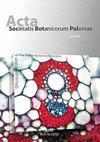Physiological and Gene-Expression Variations in Watermelon (Citrullus lanatus L.) Cultivars Exposed to Drought Stress
IF 0.8
4区 生物学
Q3 PLANT SCIENCES
引用次数: 1
Abstract
Drought conditions may have direct or indirect effects on plant physiology, biochemistry, and molecular characteristics. The purpose of this study was to investigate the effects of drought stress on the physiological, biochemical, and molecular responses of three different watermelon cultivars with varying levels of drought tolerance (24: drought resistant, CS: moderately tolerant, and 98: drought sensitive). The cultivars exhibited different responses to cope with water stress according to their tolerance level. Drought induced significant reductions in chlorophyll a, total chlorophyll and carotenoid content and glutation reductase and ascorbate peroxidase activity in the sensitive cultivar unlike in the moderately tolerant and drought resistant cultivars. Additionally, the expression levels of NAC1, NAC2, ORE1, WRKY24, SAG12, SAG13, KCS2, CER1, DREB2A, LTP3, SWEET15, and PYL9 genes were measured using qRT-PCR. The expression ratios of the genes significantly varied depending on the gene location and on the tolerance of the cultivars. Results showed that the physiology and biochemical and molecular pathways of tolerant cultivars change to adapt to drought conditions. Therefore, the drought-resistant cultivar copes with drought stress by increasing proline content and antioxidant enzyme activities, as well as by increasing the expression of specific genes.干旱胁迫下西瓜(Citrullus lanatus L.)生理及基因表达的变化
干旱条件可能对植物的生理、生物化学和分子特性产生直接或间接的影响。本研究的目的是研究干旱胁迫对三个不同抗旱水平的西瓜品种(24:抗旱、CS:中度耐受和98:干旱敏感)的生理、生化和分子反应的影响。不同品种对水分胁迫的耐受程度不同,表现出不同的反应。干旱导致敏感品种的叶绿素a、总叶绿素和类胡萝卜素含量、戊二酸还原酶和抗坏血酸过氧化物酶活性显著降低,这与中度耐受和抗旱品种不同。此外,使用qRT-PCR测量NAC1、NAC2、ORE1、WRKY24、SAG12、SAG13、KCS2、CER1、DREB2A、LTP3、SWEET15和PYL9基因的表达水平。基因的表达率根据基因位置和品种的耐受性而显著变化。结果表明,耐干旱品种的生理生化和分子途径随着干旱条件的变化而变化。因此,抗旱品种通过增加脯氨酸含量和抗氧化酶活性以及增加特定基因的表达来应对干旱胁迫。
本文章由计算机程序翻译,如有差异,请以英文原文为准。
求助全文
约1分钟内获得全文
求助全文
来源期刊
CiteScore
2.00
自引率
10.00%
发文量
18
审稿时长
1 months
期刊介绍:
The journal has been published since 1923 and offers Open Access publication of original research papers, short communications, and reviews in all areas of plant science, including evolution, ecology, genetics, plant structure and development, physiology and biochemistry.

 求助内容:
求助内容: 应助结果提醒方式:
应助结果提醒方式:


